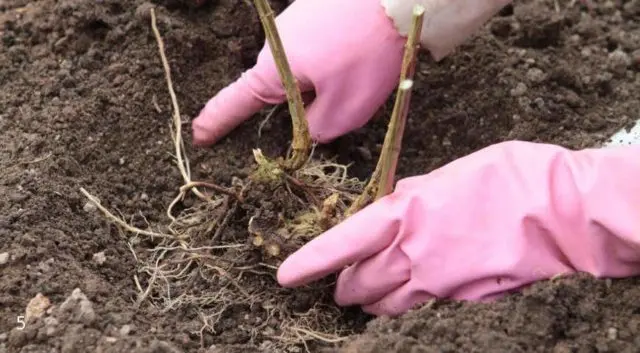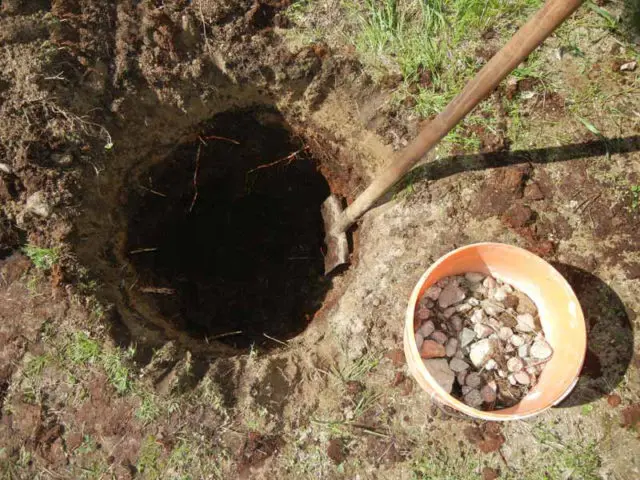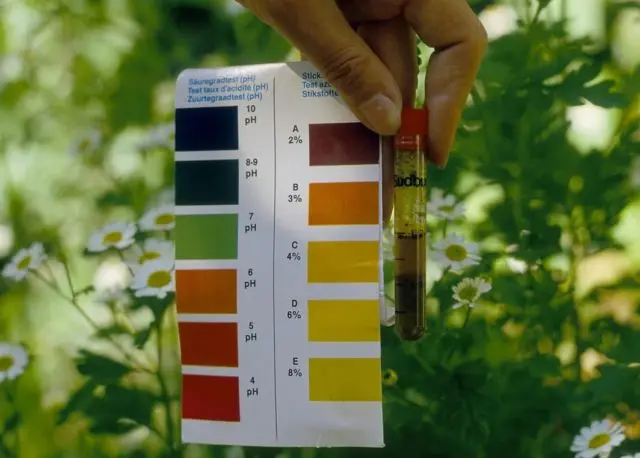Contents
Self-cultivation of hydrangeas, both by seed and by cuttings, takes quite a lot of time. However, there is a faster way to increase the abundance of this magnificent plant in the garden. Under certain conditions, planting a garden hydrangea by dividing a bush can be done quite quickly, without spending significant effort.
Is it possible to propagate hydrangea by dividing the bush
Hydrangea is a wonderful perennial shrub that can decorate any personal plot. Of course, many flower growers would like to propagate it on their own, so as not to spend money on expensive seedlings. This can be easily done by dividing an adult bush.
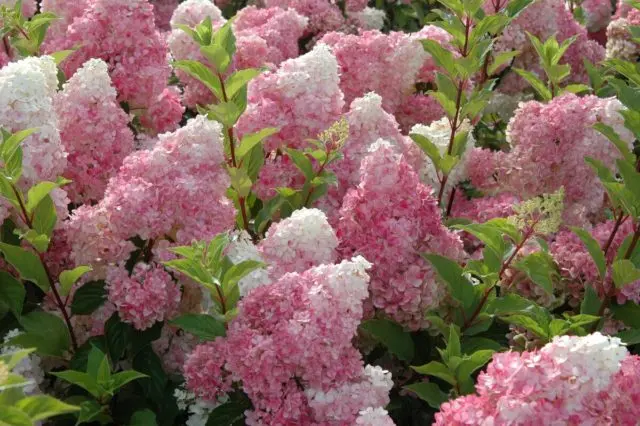
Hydrangea is the real queen of the garden
This method is applicable for a large number of perennial shrubs, including for hydrangeas that have a bush form. Unlike cuttings, this process takes much less time, allowing you to get clones of the mother plant in a short time.
Pros and cons of propagating hydrangeas by dividing the bush
The vegetative method of hydrangea propagation by dividing the bush into separate parts is widely used in ornamental gardening. The positive aspects of this method are the following factors:
- The new plant is completely identical to the parent plant, all species and varietal characteristics are preserved.
- The divided parts of the plant in many cases begin to bloom the very next year after planting.
- High percentage of rooting delenok.
- The simplicity of the method.
- You can combine the division of the bush with a plant transplant or with the replacement of soil in a container.
The division method also has disadvantages. Here is some of them:
- The number of divisions is limited by the number of renewal buds per rhizome.
- The hydrangea bush must be mature and have a large number of shoots.
- Digging and dividing the bush requires considerable physical effort.
- Work can only be done for a short period of time per year.
- The resulting delenki must be immediately planted in a new place.
Despite all the shortcomings, propagating hydrangeas by dividing the bush is a quick and effective way to breed the desired variety. It is especially convenient to use it when planting potted plants that need periodic soil replacement. In this case, the work can be combined.
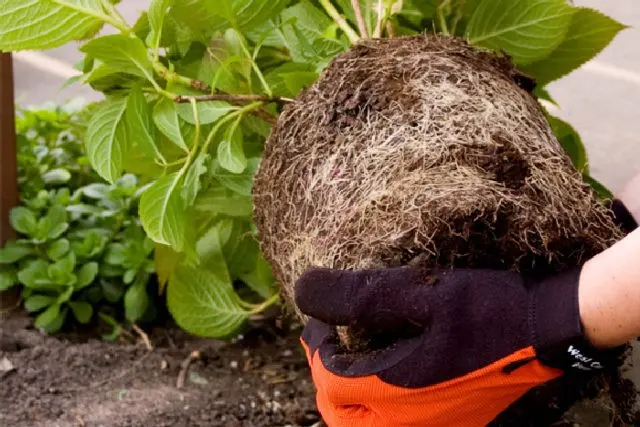
You can share not only garden hydrangeas, but also potted
In addition, by adjusting the artificial microclimate, it is possible to significantly increase the periods of the year during which division can be carried out.
When to plant a hydrangea by dividing the bush
One of the necessary conditions for dividing a bush and transplanting its parts to a new place is a dormant period. This is a short period of time when the plant has not yet entered the growing season or has already completed it, while the ambient temperature has positive values. Such conditions are observed in spring and autumn.
How to divide a hydrangea bush in spring
The work on dividing the hydrangea bush in the spring should be started after the soil has completely thawed, the temperature indicators will confidently start to stay above zero, while the plant itself will not show any signs of the beginning of the growing season – swelling of the buds. In different regions, this time can vary significantly due to the climate, in Central Our Country it is approximately the middle or end of April.

It takes a lot of effort to dig up a hydrangea bush.
To properly divide the hydrangea bush, it is dug around from all sides and carefully removed from the ground. After carrying out all the preparatory measures, it is carefully cut into several independent parts, each of which should have its own root system and several renewal shoots. Then they are seated in pre-prepared separate landing pits.
How to divide a hydrangea bush in autumn
In autumn, the division of bushes of a tree or any other hydrangea is recommended only in a warm climate. If the weather conditions are not quite suitable, then it is likely that the plant will not have time to acclimatize in a new place and will die with the onset of cold weather. If the region has a warm winter, then the reproduction of hydrangea bushes by division can be started after the shrub has completely faded. At the same time, before the onset of cold weather, there should be enough time left for the delenki to take root in new places. The very procedure for dividing a hydrangea bush does not differ from the spring one.
At the same time, it is possible to carry out the procedure with shrubs growing in winter gardens, indoor greenhouses and other rooms with artificial climate control.
How to propagate hydrangea by dividing the bush
Before dividing the bush, the horse zone of hydrangeas must be shed with water. This will make it easier to remove the plant both from the open ground and from the container. After that, the earth is removed from the roots with a pressure of water from a hose. After cleaning, it is advisable to rinse the root system with a weak solution of potassium permanganate. Such a preventive measure will protect plants from infections that can be introduced when dividing the rhizome.
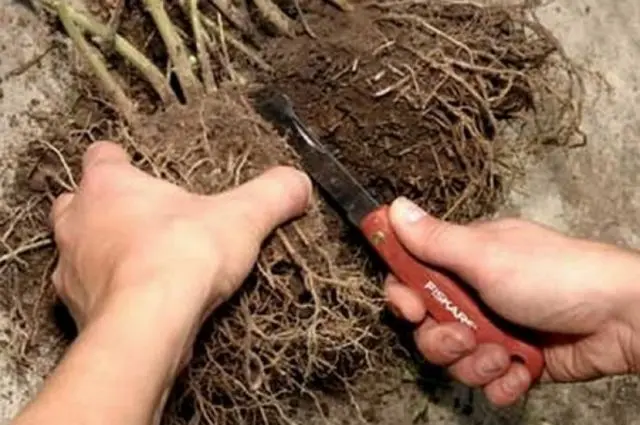
Separation of the root is done with a sharp knife or secateurs.
Further work order:
- From the bush gradually, with the help of a knife, separate independent parts containing shoots with their own root system.
- The central part of the bush, extending from a powerful tree-like root, is left untouched. She will remain an independent division and is planted entirely.
- Roots that are too long must be trimmed.
- After separation, all large sections and chips should be burned with brilliant green or sprinkled with powder from crushed charcoal.
- Delenki are planted in planting pits and covered with a mixture of peat and high ground, and then watered abundantly.
- Planted plants are pruned, leaving 2-3 growth buds on the shoots.
In more detail, the process of reproduction by dividing a large-leaved hydrangea bush grown in a pot can be viewed in the video:
Caring for a hydrangea bush after dividing
The first time after planting hydrangea seedlings, increased care is needed. The root zone should be regularly moistened, but not flooded. You need to focus on the amount of precipitation, if there is enough of it, then excessive moisture can only damage the hydrangeas. It is better to mulch the top layer of soil with the bark of coniferous trees or their fallen needles, this retains moisture in the soil and helps maintain its acidity. You can use fresh spruce sawdust as mulch. In the first few weeks, before the planted delenki take root, it is better to shade them with special screens, avoiding direct sunlight on them.

After planting, the root zone must be mulched.
This is especially true of large-leaved hydrangea, because of its thermophilicity, many flower growers grow it exclusively as a potted plant.
Tips from experienced gardeners
In order for the reproduction of hydrangeas by dividing the bush to be successful, you can use the tips offered by experienced flower growers. Here is some of them:
- By dividing the bush, panicle hydrangea bushes can be propagated when creating hedges, since all future plants will not only be of the same variety, but also approximately the same size.
- You can divide small-sized hydrangea bushes with your hands, if you have enough physical strength. In this case, care must be taken not to injure yourself or the plant.
- To separate the root, it is convenient to use a garden pruner. Before work, its cutting edges must be treated with any alcohol-containing liquid so as not to cause infection.
- If a small number of delenok is needed, then the hydrangea bush can not be completely dug up. It is enough to dig out only part of the root system by digging on one side. After that, carefully separate the required amount of overgrowth, sprinkle the slices with charcoal and again cover the root zone of the shrub. Delenki need to land immediately.

All received delenki must be landed immediately
- Planting pits for planting hydrangea delenok need to be dug in advance. Their size should exceed the size of the root system of the seedling by about 3 times, usually they dig a hole with a diameter of 0,5 m and the same depth. At the bottom it is necessary to lay a drainage layer of crushed stone or broken brick. Hydrangea loves moisture very much, but stagnation of water in the roots should not be allowed.
A layer of drainage must be laid in the planting pits
- The root neck of seedlings is not buried when planting. Otherwise, the hydrangea may never bloom. It is recommended to plant it at the same level at which the mother plant grew before division.
- The hydrangea bush can be divided on the spot without pulling it completely out of the ground. To do this, the mother plant is gradually dug around, cutting off or pinching off delenki from the side parts.

This method is used if the shared hive is large.
- Dividing adult bushes is a great way to rejuvenate them. This procedure perfectly stimulates the plant to form new shoots.
- The soil with which the root system of hydrangea divisions is covered should have a weak acid reaction. You can check it before landing using indicator strips or a special device (PH meter). The optimal value of the acidity level is 5. If the pH is greater than this value, then peat should be added to the soil composition.

Hydrangeas need slightly acidic soil.
- On the site intended for planting hydrangeas, dolomite flour or lime cannot be used, since these substances alkalize the soil.
- Planted hydrangea delenki need to be watered regularly and plentifully. It is important to use only settled water, preferably rainwater, adding a little lemon juice to it before watering. Artesian and tap water is not recommended. The salts contained in it deoxidize the soil, and this contributes to the appearance of various diseases on hydrangeas.
- Often, after dividing the bush and planting, the hydrangea does not show signs of life for quite a long time. This situation happens if the bush is old enough, and when removing it from the ground and subsequent transplanting, it was necessary to severely cut its roots. Such hydrangeas can “sick” for a whole season, young shoots appear on them only next spring. Therefore, do not rush to draw conclusions and take drastic measures.
Conclusion
You can plant a garden hydrangea by dividing a bush simply and quickly, this method has proven itself, first of all, because the percentage of rooting of divisions is very high. In addition, the method has a number of other advantages: simplicity, fast results, complete identity of new plants and the mother bush. It is only important to observe the necessary deadlines and do all the work correctly, in this case the result will most likely be positive.










